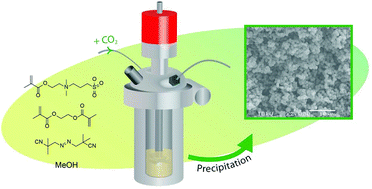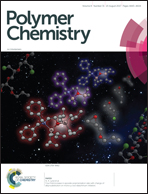One-pot synthesis of micron-sized polybetaine particles; innovative use of supercritical carbon dioxide†
Abstract
Polybetaines exhibit unique properties combining anti-polyelectrolyte and low protein fouling behaviour, as well as biocompatibility. To date, the synthesis of polybetaine particles >50 nm has proved to be extremely challenging with standard emulsion and dispersion techniques being unsuccessful. Here we present the first reported synthesis of micron-sized, discrete cross-linked polybetaine particles, using polymerisation in scCO2 with methanol as a co-solvent. Discrete particles are produced only when the methanol is efficiently removed in situ using scCO2 extraction. A relatively high crosslinking agent initial concentration (10 wt%) was found to result in the most well defined particles, and particle integrity reduced as the crosslinking agent initial concentration was decreased. A monomer loading of between 3.0 × 10−2 mol L−1 and 1.8 × 10−1 mol L−1 resulted in discrete micron sized particles, with significant agglomoration occuring as the monomer loading was increased further. A spherical morphology and extremely low size dispersity was observed by SEM analysis for the optimised particles. The particles were readily re-dispersed in aqueous solution and light scattering measurements confirmed their low size dispersity.



 Please wait while we load your content...
Please wait while we load your content...